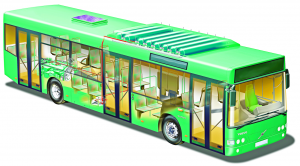The stakeholders of the bus ecosystem are leaving no stone unturned to make buses smarter and safer. Ashish Bhatia looks at some of the inclusions expected to drive the recovery of the segment.
 In the pre-Covid19 days, the new-age bus aggregator and operators plying the luxury coach were expected to look at out-of-the-box inclusions from a technology, safety, and comfort perspective. It was to justify the per seat occupancy cost levied on the passenger. Fast forward 16 months and the world has changed. Inclusions that were directly correlated to the per-seat occupancy cost, implying, a higher ticket cost must translate to greater value additions from the fleet operator. It is of utmost priority to convince passengers to consider buses as a smart and safe option for their transportation needs. It’s a sign of a maturing market and a testimony to the supply side reacting to the market pull in a bid to stay relevant. Not just in India, this phenomenon is a trend globally.
In the pre-Covid19 days, the new-age bus aggregator and operators plying the luxury coach were expected to look at out-of-the-box inclusions from a technology, safety, and comfort perspective. It was to justify the per seat occupancy cost levied on the passenger. Fast forward 16 months and the world has changed. Inclusions that were directly correlated to the per-seat occupancy cost, implying, a higher ticket cost must translate to greater value additions from the fleet operator. It is of utmost priority to convince passengers to consider buses as a smart and safe option for their transportation needs. It’s a sign of a maturing market and a testimony to the supply side reacting to the market pull in a bid to stay relevant. Not just in India, this phenomenon is a trend globally.
Smart and safe buses
It all started with the need to ensure social distancing and prevent the transmission of Covid19. In the #breakthechain phase, Original Equipment Manufacturers (OEMs) together with the stage and contract carriers have been forced to reimagine their product and service offerings. OEMs are seen taking the erstwhile concept of fully built buses to the next level. For example, Daimler India Commercial Vehicles has equipped its entire BharatBenz fleet with Covid19 safety features. In a press release, states Karl-Alexander Seidel, Chief Executive Officer and Head of Daimler Bus India, Daimler India Commercial Vehicles, “In response to the need of the hour, our BharatBenz bus fleet offers innovative solutions to mitigate virus transmission. These vehicles address people’s apprehensions towards public transport by offering reassuring features in line with Covid19 safety and hygiene protocols.”
The new additions include a range of features that are claimed to help prevent the spread of infection. The OEM, to ensure minimal surface contact, has equipped buses with a pneumatic door and hands-free sanitiser. It has also provided a hands-free temperature sensor and foot-operated trash can onboard. In the case of a passenger boarding with a temperature over 100 degrees Fahrenheit, provision has been made to alert the driver. It will also trigger a buzzer sound. In addition, the bus entrance has been furnished with disinfectant mats to clean viruses and dirt off the feet of the onboarding passengers. BharatBenz ‘BSafe’ badged buses come with two seat cover options. Out of the two, one is an infection-proof cover that retains its anti-virus and anti-bacterial protection for up to 20 washes. The second cover is an easy-to-use disposable cover for passengers who want to avoid sitting on seats previously occupied and prefer a one-time use seat cover.
The bus also comes with an Ultraviolet (UV) filter and an air circulation kit. The UV lamp is claimed to kill up to 99.6 per cent of airborne viruses while the air circulation system is said to secure ventilation of fresh air from the outside. The inclusion is said to provide an extra layer of protection against any virus which may have entered the bus despite safety precautions.




For driver safety, a glass partition has been placed between the driver’s cabin and the passenger cabin. The driver additionally will be provided with a Covid19 safety kit consisting of N95 masks, disinfectant sprays, hand sanitisers, besides anti-bacterial wipes to meet the cabin cleanliness requirements. Commuters can look forward to seeing trash cans placed on the bus. These cans will be designated for waste disposal and be supported with informative posters with the safety do’s and don’ts. “By equipping our products with ‘BSafe’ features such as hands-free doors, sanitiser and temperature sensors, we aim to revive the demand for passenger buses in India,” ‘states Seidel.
Tata Motors, recently delivered 35 Starbus electric buses, as a part of the larger order of 340 electric buses to Brihanmumbai Electric Supply and Transport (BEST). The 12-meter long, 35-seater Tata Starbus AC electric buses are equipped with advanced features for the comfort of the driver and the passengers. For instance, the OEM has provided a ‘Lift Mechanism’ that extends an automated ramp for easy ingress and egress of specially-abled passengers, along with ergonomic seats, roomy interiors, utility provisions like charging ports, and wide entry and exit passages. These buses are equipped with Intelligent Transport System (ITS), telematics system, regenerative braking system, amongst other features for efficient and smooth operations. In a press statement, Rohit Srivastava, Vice President, Product Line – Buses, Tata Motors mentions, “The unique ‘One Tata’ initiative will leverage the core proficiencies of various Tata Group companies to offer the best comfort, performance and low cost of operations. The buses are equipped with modern features that will enable ease of use and offer comfort and convenience with roomy interiors and ergonomic seats.”
In another example, Haryana roadways resumed its bus service between Gurgaon and Agra in Uttar Pradesh where Volvo buses are among buses in the fleet. It hints at an uptick in inter-state public mobility as well. An hour before the departure, a sanitization drive will be carried out and passengers will be called in early to avoid any overcrowding. Through the CampX facility in Bengaluru, which is used to spawn new business ideas and collaborations, the Volvo Group’s thrust areas include the development of new commercial transport solutions. At the group level, expect new solutions from the company to fructify since the business transfer agreement with Volvo Eicher Commercial Vehicles (VECV). VECV, on the other hand, continues its thrust on offering a wide range of transport solutions through the Eicher Starline and Skyline range of buses. The OEM is known to have delivered 50 units of 24-seater Eicher CNG buses to Pune Mahanagar Parivahan Mahamandal Ltd (PMPML). All the buses are equipped with the Eicher Live Telematics Solution linking back to the Eicher Uptime centre.
SML Isuzu is banking on its Hiroi SLTHT6 series of school and staff buses. Spacious saloon with wide gangway and full-length hatracks, anti-bacterial laminated fire redundant upholstery, school bag racks are among the standout features. Mahindra Truck and Bus, in its Cruzio bus, for instance, is banking on wider seats and spacious gangway, roomy interiors, wider doors for easy entry and exit, child check-mate feature and iMAXX for tracking the bus as inclusions to meet the demand. Besides, the bus is claimed to adhere to all safety features prescribed by the Regional Transport Office (RTO).
Driving demand
Higher budget allocation towards fleet up-gradation will drive the demand going forward according to Vipin Sondhi, Managing Director and Chief Executive Officer, Ashok Leyland. The demand is further expected to be bolstered with schools reopening in states like Maharashtra by the mid of August 2021. Safety features in school buses will assume significance and hence manufacturers and operators alike are working in the direction ahead of operations commencing. Bus sales are known to have dropped from 80,000 units pre-Covid to 15,000 units in FY2021. In the first quarter of FY22 (Q12022), the industry has sold an estimated 5,000 units. Admitting to not requiring an addition to capacity till the time the segment recovers to pre-Covid levels, the industry is all for making buses smarter and safer.
Also, read Into The Future: FY22 And Beyond



















